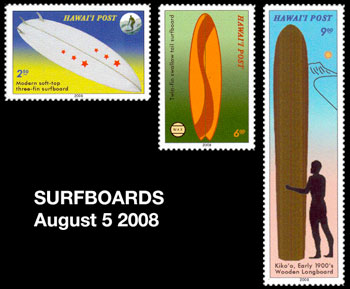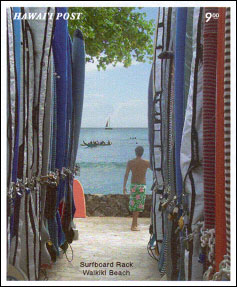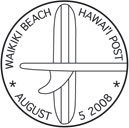.
.
.
.
.
.
.
.
.
.
.
.
.
.
.
.
.
.
.
.
.
.
.
.
.
.
.
.
.
.
.
.
.
.
.
.
.
.
.
.
.
.
.
.
.
.
.
.
.
.
.
.
.
.
.
.
.
August 5th 2008. Surfboards.
Three stamps and a mini-sheet were issued on August 5th 2008 depicting Surfboards.

British Explorer Captain James Cook upon arrival in Tahiti decribed how a native caught waves with his outrigger canoe for amusement: "Walking one day about Matavai Point, where our tents were erected, I saw a man paddling in a small canoe so quickly and looking about him with such eagerness of each side. He then sat motionless and was carried along at the same swift rate as the wave, till it landed him upon the beach. Then he started out, emptied his canoe (of sea water), and went in search of another swell. I could not help concluding that this man felt the most supreme pleasure while he was driven on so fast and so smoothly by the sea."
The first settlers to land in Hawaii were from the Marquesas Islands (one of the French Polynesia {Tahiti} groups of islands) and were most likely skilled in surfing the waves with their canoes, and that is how the Hawaiian form of the sport emerged.
In the 18th and 19th centuries, Hawaiian Royalty who surfed developed their own designs for wooden surfboards and surfed at their own private beaches. Sacred rituals were made before the construction of a Kiko'o, or surfboard for Royalty. Only three types of trees were used for making surfboards - Koa, Ulu and Wili-Wili. Before felling a tree, a board maker would place fish in holes dug next to the roots as a sacred offering to the Hawaiian gods.
There were three sizes of surfboards, Omo - around 8 feet long; Olo - around 12 to 15 feet long; and Kiko'o 15 feet or longer for Hawaiian Royalty only. Plus a small one for keiki (children).
Olympic gold medallist Duke Kahanamoku, the "Father of Modern Surfing" was born and raised in Waikiki and helped to make the sport popular not only in Hawai'i in the early 1900's, but also on his visits to the West Coast of the U.S.A. and Australia. A statue of him is in Waikiki Hawai'i, Huntington Beach, California and also at Freshwater Beach in New South Wales, Australia. All 3 statues include him with a surfboard. See August 24 2002 issue FDC
In the 1950's, surfboards began to change with the introduction of polyurethane foam Boards became lighter and easier to make. Plus theycould be individualized with bright colors and logos.
The original Hawaiian wooden boards had no fins. With modern boards, a fin was added to the back on the underside of the board, then 2, then 3. Modern improvements include a leash which tethers one of your ankles to the board, so you don't lose your board in a "wipe out". The most recent innovation is a soft top to the board making it more comfortable, especially when paddling "out the back" with your knees on the board.

The $2.50 stamp (top left) shows a Modern 3-fin soft-top Surfboard. This board is ideal for quick manoeuvers on the waves
The $6 stamp (top middle) shows a Twin-fin swallow tail surfboard. The swallow tail allows for sharp turns on the waves. A typical small packet of surfing wax is shown in the bottom left. This is to wax down the upper surface of the board for better grip with your feet when standing on the board.
The $9 stamp (top right) shows a typical wooden surfboard of the early 1900's, called a longboard today as it is so long compared to modern surfboards. Diamond Head is in the background.
The $9 minisheet (above) prepays the Same Day rate. It shows the Surfboard Rack at Waikiki Beach with the Pacific Ocean in the background.

The special postmark for this issue shows a top view and a side view (with rear fin) of two different surfboards.
WE ACCEPT CREDIT CARDS ON ALL ORDERS
![]()
![]()
![]()
![]()
Technical details of the stamps and mini-sheet:
Colors: $2.50, $6 & $9 stamps and $9 mini-sheet - Multicolored
Size: 75mm x 62mm (mini-sheet)
Stamps sheet size: $2.50 - 30 (5 across, 6 down). $6 - 30 (6 across, 5 down). $9
Perforation: Stamps - perf 12. Mini-sheet - imperforate.
Stamps and Mini-sheet design: Enelani.
Layout & Pre-press: Enelani.
Printer: Hawai'i Security Printers, Honolulu, Hawai'i.
Printing Method: 4-color (Cyan, Magenta, Yellow and Black) printing process.
Sheet margin markings: HAWAI'I POST (top middle), "Traffic Light" showing 4 colors used in printing (lower left side), © 2008 Hawai'i Post (lower right side) & Hawai'i Security Printers, Honolulu, Hawai'i. (bottom middle)
Paper: GPA coated white stock with water-activated gum on the back.
Return to list of stamp issues
For details on upcoming stamp issues click here